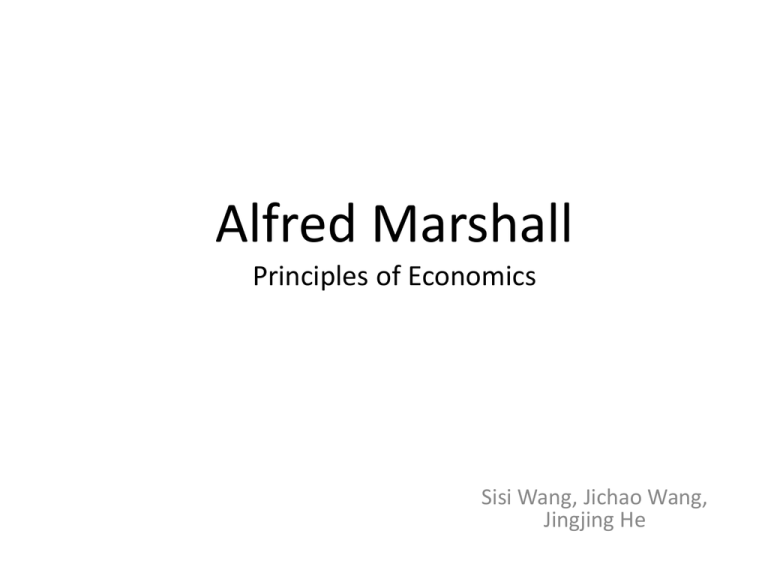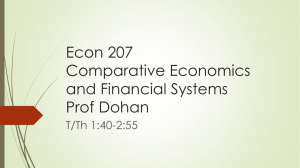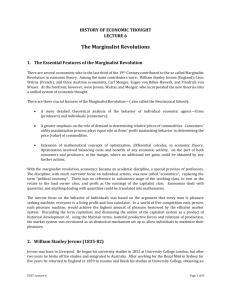Alfred Marshall Principles of Economics
advertisement

Alfred Marshall Principles of Economics Sisi Wang, Jichao Wang, Jingjing He Biography • Born on July 26, 1842 in Bermondsey, London, England; died on July 13, 1924. • His father was a bank cashier • Grew up in the London suburb of Clapham • Educated at the Merchant Taylors’ School, Northwood and St John’s College, Cambridge • 1885, he became professor of political economy at Cambridge • Retired in 1908 Career • Marshall experienced a mental crisis so that he gave up physics and switch to philosophy. • Began with metaphysics and led him to ethics, specially a version of utilitarianism. • Ultimately, led him to economics. • Even as he turned to economics, his ethical views continued to be a dominant force in his thinking. Thoughts interacted with… • • • • Adam Smith David Ricardo John Stuart Mill Etc… Principles of Economics • One of the greatest economic works • His specialty was microeconomics– the study of individual markets and industries • Emphasizes that the price and output of a good are determined by both supply and demand • Modern economists also use Marshall’s approach to figure out economic problems Let’s go through his book in details Research fields and topics 1. On Micro level, • Wants, utility, and elasticity of demand. • Agents of Production On land On labour On capital On industrial organization • Theory of equilibrium • Analysis of marginal values Research fields and topics 2. On a wider Micro level, • Distribution of the national labour Labour income Profits of capital Rent on land Wants, utility, and elasticity of demand 1. Human wants • Human not only chase the large quantities, but also good qualities of things. • Human desires also affected by the common senses and social activities. • As man becomes developed, their needs and wants will also become subtle and various. • Theory of consumption is not really the scientific basis of economics… Wants, utility, and elasticity of demand 2. Consumers’ demand • Consumers’ demand governs trader’s demand. • Utility relates to wants and desire. • Marshall’s opinion: A person’s demand for a thing should always “reference to the prices at which he would buy that amount and other amounts”. • The law of demand: The amount demanded increases with a fall in price, and diminishes with a rise in price. Wants, utility, and elasticity of demand 3. Elasticity of demands • Marshall’s description “His willingness to purchase the thing … the elasticity of his wants”. The general law of elasticity Variations of the general law of elasticity Normal goods, luxuries, necessaries…… About people’s tastes and uses “The demand for things of a higher quality depends much on sensibility” There are difficulties of getting exact lists of demand prices. a) b) c) Purchasing power is continually changing; Gradual growth of population and wealth; Changes in fashion, tastes and habits. Theory of Equilibrium 1. Prerequisite: market • “The central point of a market is the public exchange, mart or auction rooms, where the traders agree to meet and transact business”. Theory of Equilibrium 2. Temporary equilibrium • The simplest equilibrium between desire and effort • In a barter system, a true equilibrium may not exist. But this temporary equilibrium will be found in markets. Theory of Equilibrium 3. Stable equilibrium • In a stable equilibrium, the law of supply and demand works as a mechanism Free market conditions General conditions of demand General conditions of supply • What is meant by equilibrium? • Such equilibrium is stable: the equilibrium is stable for displacements in different directions. Theory of Equilibrium “When therefore the amount produced (in a unit of time) is such that the demand price is greater than the supply price, then sellers receive more than is sufficient to make it worth their while to bring goods to market to that amount … On the other hand, when the amount produced is such that the demand price is less than the supply price, sellers receive less than is sufficient to make it worth their while to bring goods to market on that scale … When the demand price is equal to the supply price, the amount produced has no tendency either to be increased or to be diminished; it is in equilibrium”. —Book V, Chapter III, Section 6 Theory of Equilibrium 3. Stable equilibrium • In a stable equilibrium, the law of supply and demand works as a mechanism Free market conditions General conditions of demand General conditions of supply • What is meant by equilibrium? • Such equilibrium is stable: the equilibrium is stable for displacements in different directions. Analysis based on marginal values 1. Marginal utility and marginal costs • Marginal utility “The part of the thing which he is only just induced to purchase may be called his marginal purchases … and the utility of his marginal purchase may be called marginal utility of the thing to him”. The marginal utility of a thing diminishes with every increase in the amount of it he already has. (The law of diminishing returns) The condition is that we do not suppose for any alteration in the character or tastes the buyer. • Marginal cost Analysis based on marginal values 2. The tendency of diminishing returns • “An extra return smaller in proportion than he gets for the last applications of capital and labour that he now makes, provided of course that there is meanwhile no perceptible improvement in his agricultural skill”. • We need not assume that the tendency of diminishing returns will last forever. Analysis based on marginal values 3. However, marginal uses and costs do not govern values. • Marshall thinks that “but marginal uses do not govern value; because they, together with value, are themselves governed by those general relations”. • What are those general relations? —The law of demand and supply governs value. Theoretical contributions • Marginalist revolution • Price elasticity of demand • Quasi-Rent • Institutional economic Marginalism • Believes economic value is set by the consumer's marginal utility • Seeks a level of operation of some activity that will maximize the net gain from that activity Marginalist revolution • Concern discovery of marginal utility theory, which occurred in the 1870’s. • Consumers attempt to adjust consumption until marginal utility equals the price The marginal theory of value • First broached in the 1870s • Revolutionized economics. • The value of an item is a reflection of the work and resources devoted to making it, or the cost-of-production theory of value. Price elasticity of demand Quasi-Rent • Reward paid to a factor which exceeds its opportunity cost • The rent is a necessary incentive for something What do quasi-rents compensate for? • Innovation • A lot of innovations are hard to patent, but an industry leader like Microsoft can be reimbursed for its R&D by winning a leading position in the market Institutional economic • Understanding the role of the evolutionary process • Role of institutions in shaping economic behavior • Emphasizes a broader study of institutions and views markets as a result of the complex interaction of these various institutions New institutional economics • Coined by Oliver Williamson in 1975 • Integrates later developments of neoclassical economics into the analysis • Has its roots in two articles by Ronald Coase, "The Nature of the Firm" (1937) and "The Problem of Social Cost" (1960) New institutional economics • Modified Neoclassical framework in considering both efficiency and distribution issues • contrast to traditional institutional economics, which is critical of mainstream neoclassical economics Aspects in current NIE analyses • • • • • • organizational arrangements property rights transaction costs credible commitments modes of governance ideological values Reference • http://en.wikipedia.org/wiki/Alfred_Marshall • http://www.econlib.org/library/Enc/bios/Mar shall.html • http://econfaculty.gmu.edu/bcaplan/quasirent • Marshall, A. (1890). Principles of Economics: an Introductory Volume (9th ed.). New York, NY: Macmillan.










